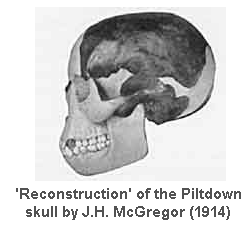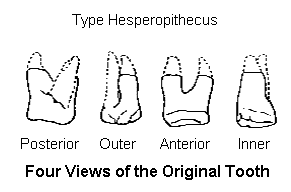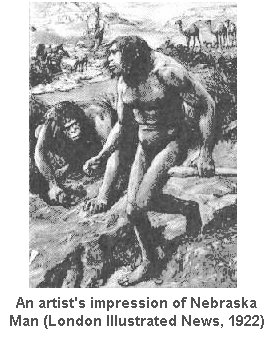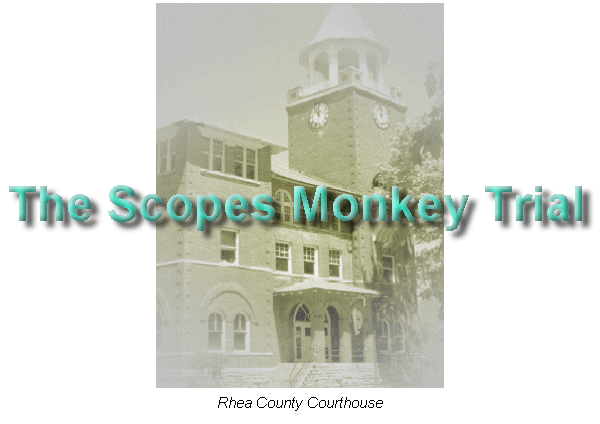Under a Bushel
It wasn't so much the expert testimony that the Defense lawyers were concerned about, so much as the experts themselves. As Hays later admitted:
"Cross-examination would have shown that the scientists, while religious men - for we chose only that kind - still did not believe in the virgin birth and other miracles."
In other words, the ACLU and Hays - and presumably the other Defense lawyers, including Darrow and Malone - knew full well that when they talked about finding scientists who were also "Christians", the only kind of 'christian' scientists they could find were men who followed such a watered-down kind of 'faith' that their whole 'science and religion in harmony' scenario would be exposed as a complete sham if the men were questioned on this topic. Once again it was Arthur Hays who subsequently explained the logic behind the defense team's tactics:
"It was felt by us [i.e. the ACLU] that if the cause of free education was ever to be won, it would need the support of millions of intelligent churchgoing people who didn't question theological miracles."
Or in plain English, the real reason why Arthur Hays and the ACLU didn't want their expert witnesses to go on the stand and give their testimony live was because the "christian" scientists story was nothing but a lie.
Incidentally, what Hays meant by "free education" was freedom to teach those ideas favoured by the ACLU and its supporters - such as the "chattering classes" of 1920s New York - not free schooling as in "the best education for all children, regardless of race, creed or colour - or personal wealth".
It is easy to see why the ACLU were so afraid of having Darrow, the arch-atheist, as part of the defense team. It is a lot harder to see how the ACLU's tactics could be interpreted as anything other than the most cynical kind of fraud. Small wonder, then, that on the ACLU's archive website:
http://infoshare1.princeton.edu:2003/libraries/firestone/rbsc/finding_aids/aclu1920/aclu1920_1.html
their account of the Scopes trial takes up something less that one complete paragraph (about 75 words), and its value is described in exclusively self-serving terms:
"Live radio coverage and an enormous press cadre (led by five Baltimore Sun reporters, including H.L. Mencken) made the public aware of the ACLU and helped the organisation raise funds."
And you thought they were there to defend the individual's right to intellectual freedom. Well, so did I. Seems we were both mistaken.
In practice, even this simple statement displays a certain "economical usage" of the truth.
The fact is that the ACLU got very little support from its regular sources in regard to the Scopes Trial. Even though Darrow and Malone were giving their services at no charge, the ACLU managed to spend nearly $7,000 on court costs, the expenses of the eight expert witnesses, etc. At the same time the ACLU's 'Tennessee Evolution Case Defense Fund' received donations amounting to a little over $2,000.
Only in 1926, when the ACLU were allowed to send out a one-time mail shot to the members of the AAAS, were they able to turn their substantial loss into a minor gain. In the final reckoning, the outlay by the Defense Fund ran to $8,993. Contributions, even after the AAAS appeal, were only $11,328. Far from being a successful fundraising exercise, as their own assessment would have us believe, the ACLU returned $561 to contributors, and retained a mere $1,868 in a fighting fund for future cases involving "academic freedom".
(And no, I don't know where the other $106 came from, either.)
When Did You Last See Your Father?
By the 1920's there were already a number of fossil finds that were regarded as belonging to creatures in mankind's ancestral line. Professors Cole, Mather and Newman all referred to Java Man (then known as pithicanthropus erectus, meaning "erect ape-man", now upgraded to homo erectus) and to Heidelberg Man (designated as palaeoanthropus heidelbergensis - literally "old human of Heidelberg" - in 1925, now thought to be a European version of homo erectus), along with Neanderthal Man (homo neanderthalensis), who also made an appearance in Wilbur Nelson's affidavit. Despite the fact that palaeoanthropology (the study of early man) was so new in 1925 that its exponents weren't able to recognise the close similarity between the finds known as "Heidelberg Man", "Java Man" and "Peking Man", Kirtley Mather confidently, but rather rashly, declared in his affidavit that:
"There are in truth no missing links in the record which connects man with the other members of the order of primates."
In reality this was a grossly short-sighted point of view - but very common, in 1925. As archaeologist Dr. Cornwall, of the University of London, explained, many years later:
"When, in the early years of this century, Pithicanthropus from Java, the Heidelberg jaw and the Neanderthal man were the only known fossils, it was easy to see in them a line of human evolution leading directly to modern man. More recent discoveries of human ancestors, combined with our better methods of geological dating, have shown this simple explanation to be quite impossible ..."
(Italics as in the original text)
Before moving on to other aspects of the expert testimony I'd like to take a moment to introduce two characters who clearly illustrate the view of the "evolution of man" as it existed at the time of the Scopes trial.
One of these "gentlemen" - Piltdown Man - appeared in two of the expert affidavits. The other - Nebraska Man - after three years of worldwide publicity, was already (though few people knew it at the time) making his way onto the scrap heap of history.
Piltdown Man
Both Professor Cole and Professor Newman mentioned Piltdown Man in their affidavits, but in neither case did they show much enthusiasm, and with good reason.
The original evidence (skull fragments) of what came to be known as "Piltdown Man" (Eoanthropus Dawsonii - literally 'Dawn Man of Dawson') was allegedly handed to Charles Dawson, an amateur paleaontologist, by workmen digging in the gravel quarry at Piltdown in Sussex (UK).
Just when those first fragments were found is unclear. When Dawson eventually showed them to his friend Sir Arthur Smith Woodward, (Keeper of the Natural History department at the British Museum), in February 1912 he explained that they had come into his possession "some years prior". (This vague description is usually taken to mean at some time between 1908 and 1911.)
In June of that same year (1912) a digging team consisting of Dawson, Woodward and the French Jesuit and amateur palaeontologist Teilhard de Chardin, found an elephant molar, and another skull fragment. On a further occasion right parietal skull bones and a jaw bone were discovered on the site.
In November 1912 the Press publicised the news of this "earliest Englishman", and in December an official presentation of the evidence was given at a meeting of the Geological Society in London.

It is worth mentioning, here, that whilst the British scientific establishment largely supported the validity of Piltdown Man, this was not the case in America and Europe. Although they were not able to see the evidence firsthand, a number of experts rightly, as we now know, surmised that the skull fragments (which appeared to be human, or at least near-human) and the jawbone (which was said to resemble that of a chimpanzee) must obviously have come from different creatures and that their close physical proximity to each other in the gravel pit was not proof, in itself, that they belonged together.
It should also be noted that Henry Fairfield Osborn and his colleague William King Gregory, both of the Americam Museum of Natural History, were initially sceptical about the validity of the finds. Indeed, Gregory actually commented on the possibility of outright fraud, in Natural History magazine, May 1914, and then seemed to reject the possibility:
"It has been suspected by some that ... [the bones] ... may even represent a deliberate hoax ...
[but] None of the experts who have scrutinized the specimens and the gravel pit and its surroundings has doubted the genuineness of the discovery."
The very next year Dawson and an anonymous friend conveniently discovered a second set of skull fragments, which was designated Piltdown II. No-one seems to have enquired very closely as to the identity of this 'friend', or the location of the second find, and Dawson didn't volunteer much information other than that the find was made in a field near Sheffield Park (about 2½ miles north-east of the Piltdown quarry).
Once again there was a significant gap between the date of the find and the public announcement - made by Smith Woodward in 1917. This was mainly because Dawson kept his new discovery more or less to himself, and Smith Woodward only obtained the fragments from Dawson's widow after Dawson's death, in 1916.
This second 'find' was crucial to the success of the Piltdown hoax, since it neatly countered the suggestion that the original group of teeth and bones had been washed or otherwise transported from other locations to form an 'accidental' collection.
Not everyone was convinced by Piltdown II, but Henry Fairfield Osborn obviously came to regard the two sets of evidence as being beyond question. So much so that in the third edition (1924) of his book Men of the Old Stone Age we find this positively effusive assessment:
"In this channel [at the Piltdown site] were found the remains of animals of the same age as the Piltdown man, a few flints resembling eoliths, and one very primitive worked flint of the Pre-Chellean type ... These precious geologic and archaeologic records furnish the only means we have of determining the age of Eoanthropus, the 'dawn man', one of the most important and significant discoveries in the whole history of anthropology."
In reality, Osborn was as seriously off beam in his support for Piltdown Man as he was in throwing his lot in with Nebraska Man (of which more in just a moment).
Although it took some 40 (forty) years to get to the truth, in 1953 Piltdown Man was exposed as a total hoax, consisting of skull fragments most probably from a South American Ona indian and the jaw bone of an East Indian Orang-utan. Modern dating methods showed that none of the Piltdown fragments was more than 650 years old.
Osborn, like so many of his colleagues, had been well and truly hoaxed. Yet if he had gone to Dayton to give expert testimony, as originally planned, can there be the slightest doubt that his testimony would have included reference to Piltdown Man as "one of the most important and significant discoveries in the whole history of anthropology"?
But Osborn didn't go to Dayton. In fact he didn't even provide a written copy of his testimony. Because Osborn, ever on the lookout for proof of man's ancient ancestry, had already come sadly unstuck due to his over-enthusiastic support for the single tooth that came to be known as Nebraska Man.
Nebraska Man
Nothing in the history of evolution seems to have aroused such widespread misconceptions as the case of Nebraska Man, as illustrated by two quotations:
In 1922 Senator W.J. Bryan was campaigning against children being taught that they were descended from apes, and eventually went to court to fight the famous 'Scope's trial. While the case was in progress, a tooth was found in Nebraska which Prof. Osborn of the American Natural History Museum claimed had characteristics that were a mixture of human, chimpanzee and Pithecanthropus. ...
What is of particular interest however is the timing of this 'discovery' of the tooth which took place whilst the court case was still going on. I have no proof in support of my views but I cannot help suspecting that it was deliberately timed and given a great deal of publicity at that precise moment in an effort to sway the final outcome of the case. As it was, Bryan won, but was awarded a derisorily small sum as damages."
To be quite blunt, these comments, from Malcolm Bowden's book The Rise of the Evolution Fraud (Sovereign Press, 1982), are almost pure nonsense from beginning to end:
- The original Nebraska Man tooth was found nearly a decade before the Scopes trial, though it was only passed to Osborn in 1922. Further teeth were discovered in 1925 and 1926, but far from supporting the case for Nebraska Man they actually confirmed that all of the teeth were from a species of wild pig
- Professor Osborn was on the staff of the American Museum of Natural History, not the American Natural History Museum
- The bulk of the publicity concerning Nebraska Man came during 1922 - still three years before the Scopes trial - and could hardly have been "[deliberately] timed and given a great deal of publicity at that precise moment in an effort to sway the final outcome of the case"
- As to the final sentence, the mind boggles. The author appears to believe that the 'Scopes Trial' was some kind of private prosecution of Scopes by Bryan!
So much for this particular anti-evolutionist's account of the trial. But before we get too complacent and assume that only anti-evolutionists can bodge their research, take a look at a second account, this time from anti-creationist Donald Lindsay (this material is on the University of Colorado website, but I have been unable to determine what position Mr Lindsay occupied/occupies at the university):
"In 1922, a Nebraska geologist sent a fossilized tooth to Henry Osborn, head of the American Museum of Natural History. Osborn was involved with the Scopes Monkey Trial, and was delighted at the new evidence for his side. He rushed to publication, and announced the new species Hesperopithecus ("Ape of the western world"). It seemed, he said, more human than ape.
... Now, was there a fraud? No. Osborn made every effort to obtain more evidence, and when he found it, he published that too, even though he was embarrassed and disappointed. ...
Some Creationists have claimed that Nebraska Man was part of the evidence at the Scopes Monkey Trial. In fact, Judge Raulston excluded all expert testimony, except that of William Jennings Bryan."
Lindsay's material, though less detailed, still contains some significant errors:
- Once again, since Osborn received the tooth in 1922, he clearly cannot have been "involved in the Scopes Monkey Trial" [of 1925] at the same time
- Osborn most certainly did not "[make] every effort to obtain more evidence", nor did he publish the new evidence "when he found it". On the contrary, when the roof caved in on Hesperopithicus, Osborn passed everything to his colleague William King Gregory and left it to him to make the "funeral" arrangements.
- As we have already seen, Judge Raulston heard expert testimony from a defense witness, Dr Maynard Metcalf, on Day 4 of the trial, as well as the evidence from Bryan on Day 7. He also allowed the affidavits of all of the expert witnesses to be read into the court record on the morning of Monday, July 20th.

Returning, for a moment, to the assertion that Osborn "made every effort to obtain more evidence" regarding Hesperopithecus, the facts simply do not support this conclusion.
Osborn had been warned, years before, about the difficulty of dating remains such as this tooth, and he had deliberately ignored doubts about the nature of the tooth voiced as early as 1923, (though no further work at the site was initiated until the Spring of 1925).

It is also the case that, throughout the intervening period Osborn frequently used Nebraska Man as a 'stick' with which to beat Bryan in the popular press.
In 1922 he jokingly (?) suggested that Nebraska Man might have been better named as Bryopithecus "after the most most distinguished Primate which the State of Nebraska has thus far produced."
As late as May 1925 he wrote an article for The Forum, entitled "The Earth Speaks to Bryan" (a play on Job 12:8 - "Speak to the earth and it shall teach thee"), in which he asked:
"What shall we do with the Nebraska tooth? ... Certainly we shall not banish this bit of Truth because it does not fit in with our preconceived notions and because at present it constitutes infinitesimal but irrefutable evidence that the man-ape wandered over from Asia into North America."
Brave words, but not exactly well-judged.
In late June, Osborn was still listed amongst the eleven scientists "who will be called to testify in defense of John T. Scopes" (New York Times, June 26, 1925). When Bryan arrived in Dayton (July 7) he made it clear to reporters that he was looking forward to the opportunity of confronting Osborn and Nebraska Man head on. Yet where was Osborn? And where was Hesperopithecus? Certainly not in Dayton. Nor would they ever arrive.
Although Osborn responded to Bryan's widely publicised jibes the very next day, with a full page defence of evolution in The New York Times, Nebraska Man was suddenly conspicuous by his absence. Likewise Osborn himself, far from attending the trial, stayed safe and sound in New York, without even supplying an affidavit of his testimony.
So what had happened to bring about this total volte face?
We may never know for sure, but the most likely explanation seems to be that the recent dig on the Hesperopithecus site turned up some item, or items, of evidence that completely undermined Osborn's claims. What we do know for sure is that, somewhere along the line Osborn realised that, far from being "irrefutable evidence" of the comings and goings of any Asian 'man-ape', Nebraska Man was, in reality, nothing more significant than a species of wild pig. This would not be made public, however, until very late in 1927 when William King Gregory published a short article in Science with the somewhat equivocal title, "Hesperopithecus apparently not an ape nor a man".
Contrary to Bowden's claim that "little publicity was given to that discovery", on February 20, 1928, the retraction made the front page of The New York Times under the very unambiguous headline "Nebraska ape tooth proved a wild pig's". The London Times published the news the next day, albeit back on page 16, in an item headed "Hesperopithecus dethroned".

